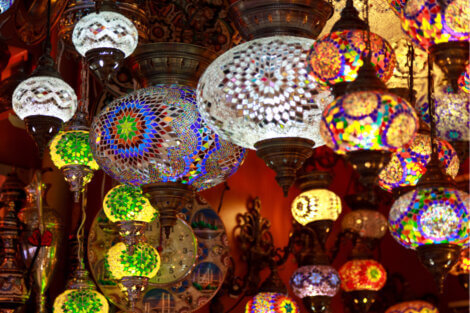Charming Turkish Lamps for Decorating Your Home

Lighting is one of the key points when it comes to highlighting the decoration of any space, whether your home, office, restaurant, etc. In addition to setting and giving light, lamps also fill a space with beauty, highlighting the style you’ve chosen. Hence the importance of seeking aesthetic lighting, such as Turkish lamps.
We’ll tell you a little about their history and how you can use them to create atmospheres that range from the bohemian touch to the most elegant and sophisticated.
A little history of Turkish lamps

The use of glass throughout history has given rise to great craftsmen and the origin of these lamps dates back to Turkey. In the sixteenth century, Turkey reached a high level of development manufacturing vases, jars, glasses, bottles, and many other objects. Colored oil lamps made in this period were the first Turkish lamps.
Turkish artisans came to develop pressing and casting techniques with which they were able to make pieces of brightly colored glass and varied shapes. Once this process was mastered, they began to use small fragments and to glue them geometrically on a piece of glass.
Tiffany’s love story with Turkish lamps
Over time, the shades for these glass lamps became objects of desire, which made their level of sophistication grow. By the end of the 19th century, they had reached perfection. On one of his trips to Europe, the American artist Louis Comfort Tiffany discovered them in Istanbul. He fell so deeply in love with them that on his return, he began to copy the design in his workshops.
Tiffany made some changes to the process and design, launching it on the market in 1893 and it turned out to be a huge success. It was then that these Turkish lamps with a history were commercialized and branded worldwide as “Tiffany lamps”.
How to distinguish an antique Turkish lamp from a modern one

Jewels or precious stones are no longer used to adorn them, and yet they remain beautiful.antique
- Cracks: With the passage of time and changes in temperature, glass expands, and contracts, which can cause small fractures. If the lamp is completely smooth, it’s probably new.
- Color: although the aesthetics remain the same, the coloring techniques have changed and the glass on new lamps is usually more intense and darker.
- Weight: although the quality hasn’t changed, even the original Turkish lamps don’t have so many excess materials, making them lighter. If you find one that’s heavy, don’t hesitate – it’s old.
The most colorful decoration
Adding handcrafted pieces to the decoration of any space always gives that elegant and personal touch, even more so if it’s a piece as beautiful and with as much history as Turkish lamps.
These are elements that adapt perfectly to both interior and exterior spaces, with the hanging models with their arabesque motifs and warm, soft lighting being favorites for chill-out areas .
Because they are timeless, you can put them either in a classic living room or a vintage bedroom. It all depends on the colors you choose, if you add a floor lamp or a ceiling lamp, and what decorative elements you decide to combine it with.
If you enjoy conservative and classic environments, you can put a Turkish lamp on a dark wood piece of furniture; whereas hanging lamps are ideal for people looking for relaxed and bohemian spaces.
Turkish lamps have that special touch that will fill any space with life. Whether you’re looking for one in a street market in your city or if you prefer the classic and refined Tiffany style, you’ll enjoy this beautiful piece.
Don’t limit these lamps to the living room or bedroom – they even look great in the bathroom. Experiment and expand your skills as an interior designer.